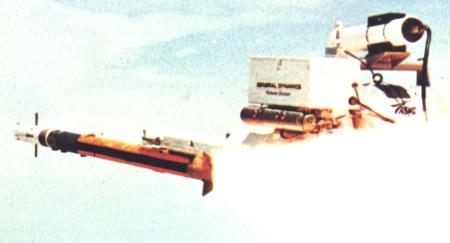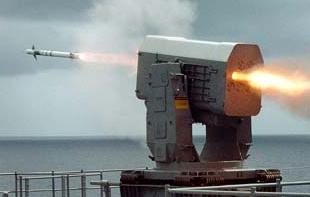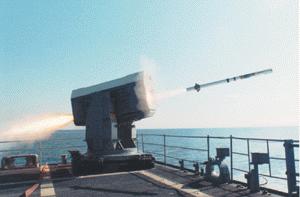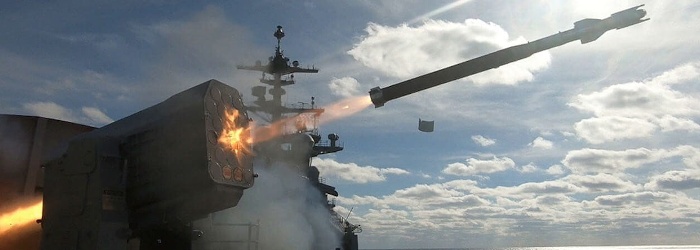Raytheon (General Dynamics) RIM-116 RAM
The RIM-116 RAM is a joint U.S./German lightweight ship-borne self-defense system for use against anti-ship cruise missiles.
In the mid-1970s the U.S. Navy ships had no adequate defense against low-flying cruise missiles. A program to develop a 5-inch missile was begun in 1975, and in July 1976 an agreement was signed with Germany for joint development of the RIM-116 weapon system. The missile was later called RAM (Rolling Airframe Missile), because it was spinning during flight. To save costs, the RAM was designed to use several existing components, including the rocket motor of the MIM-72 Chaparral, the warhead of the AIM-9 Sidewinder and the IR seeker of the FIM-92 Stinger. The XRIM-116A first flew in 1978, and a full-scale development contract was awarded to General Dynamics in June 1979. Experimental training rounds were designated XRTM-116A at that time. Numerous development problems were encountered during the 1980s, and although several successful test intercepts were made during 1982/83, it took until 1987 that RAM was finally approved for continued development to production status. After operational evaluation in early 1990, the RIM-116A (also known as RAM Block 0) was finally declared ready for operational service with the U.S. Navy in 1992.
 |
| Photo: U.S. Navy |
| XRIM-116A |
The RIM-116A is the missile component of the MK 31 GMWS (Guided Missile Weapon System), and is launched from MK 49 GMLS (Guided Missile Launching System), a box-launcher holding 21 missiles. The production RAM is powered by a MK 112 solid-propellant rocket motor. After launch, the passive RF seeker homes on the incoming cruise missile's radar emission. Because of the rolling airframe, only two RF antennas and two forward steering fins are necessary instead of the usual four in a non-spinning missile. When the missile is close enough to the target or the latter stops its emitter, it switches to IR terminal homing. The 9.1 kg (20 lb) WDU-17/B blast-fragmentation warhead is triggered by a laser proximity fuze. The RTM-116A is the RAM Block 0 training round.
 |
 | |
| Photos: U.S. Navy | ||
| RIM-116A | ||
In 1993, the development of the upgraded RIM-116B RAM Block 1 (sometimes called RAM II) was initiated. The RIM-116B has new "IR-all-the-way homing" guidance modes in addition to the RF/IR of the RIM-116A. The "IR only" mode is used against threats which do not emit detectable RF radiation. The second new option is called IRDM (IR Dual Mode Enable). In that mode, the RAM is launched with IR guidance enabled, but can switch to passive radar homing when the target's radiation becomes adequate to guide on. For IR-all-the-way guidance, the RIM-116B's IR seeker must be able to search and lock on the target after launch. After operational testing in early 1999, the RAM Block 1 was declared suitable for service, and full-scale production was approved in January 2000. The unarmed Block 1 training round is designated RTM-116B.
An alternative launching system for RAM is the Raytheon SeaRAM MK 15 MOD 31/32/33 CIWS (Close-In Weapon System). It uses the radar, electro-optical sensors and some target detection and fire control electronics of the earlier gun-based MK 15 Phalanx CIWS, and combines that with an 11-missile box-launcher for RAM. It has the same footprint and power requirements as Phalanx, and therefore replacing the latter with SeaRAM is relatively uncomplicated.
In the 2005/06 time frame, development of the significantly improved RIM-116C RAM Block 2 version was begun. Block 2 features four instead of two movable canards, 40% larger canards, and a new boost/sustain rocket motor of 15.9 cm (6.25 in) diameter. The changes significantly enhance the missile's kinematic envelope in terms of range and manoeuverability. Low-rate production started in 2012, the first deliveries to the U.S. Navy occurred in 2014, IOC (Initial Operational Capability) was achieved in May 2015, and full-rate production approval was given in 2018. The RTM-116C is the Block 2 training missile.
 |
| Photo: Raytheon |
| RIM-116C |
The RIM-116D RAM Block 2A, developed since 2016, introduces software improvements to the missile's guidance section, to enable multi-target processing. The RIM-116D had been successfully tested by 2019, and the Navy received the first operational missiles by the end of that year. The latest version is the RIM-116E RAM Block 2B. It has an improved infrared seeker, and a missile-to-missile link (MML), so that multiple RIM-116E missiles can communicate to prioritize targets in a swarm attack. The training variants of the Block 2A and Block 2B are designated RTM-116D and RTM-116E, respectively.
RAM systems, either MK 31 GMWS or SeaRAM, are installed on many U.S. Navy surface ships, including LSD, LHA/LHD, LPD, LCS, DDG and CVN classes. By 2019, more than 5500 RAM missiles of all variants had been built by Raytheon and German prime contractor RAMSYS. Production is continuing with the latest Block 2B version.
Specifications
Note: Data given by several sources show slight variations. Figures given below may therefore be inaccurate!
Data for RIM-116A/B/C:
| RIM-116A/B | RIM-116C | |
|---|---|---|
| Length | 2.82 m (9 ft 3 in) | 2.88 m (9.45 ft) |
| Wingspan | 43.8 cm (17.25 in) | 31.6 cm (12.45 in) |
| Diameter | 12.7 cm (5 in) | 15.9 cm (6.25 in) |
| Weight | 74.4 kg (164 lb) | 88.2 kg (194.4 lb) |
| Speed | Mach 2+ | |
| Range | 9 km (5 nm) | 14 km (7.5 nm) |
| Propulsion | MK 112 MOD 1 solid-fueled rocket | Boost/sustain solid-fueled rocket |
| Warhead | 9.1 kg (20 lb) WDU-17/B blast-fragmentation | |
Main Sources
[1] Norman Friedman: "US Naval Weapons", Conway Maritime Press, 1983
[2] Norman Friedman: "World Naval Weapons Systems, 1997/98", Naval Institute Press, 1997
[3] Bill Gunston: "The Illustrated Encyclopedia of Rockets and Missiles", Salamander Books Ltd, 1979
[4] Hajime Ozu: "Missile 2000 - Reference Guide to World Missile Systems", Shinkigensha, 2000
[5] Bernard Blake (ed.): "Jane's Weapon Systems 1987-88", Jane's, 1988
[6] John Pike: GlobalSecurity.org Website
[7] U.S. Navy:
RIM-116 Rolling Airframe Missile Fact Sheet
[8] Raytheon Website
[9] European Security and Defense Website:
Inner Layer Defence Systems New Developments Against Anti-Ship Cruise Missiles and Asymmetric Threats, March 2020
Back to Current Designations Of U.S. Unmanned Military Aerospace Vehicles
Back to Directory of U.S. Military Rockets and Missiles
Last Updated: 22 December 2024